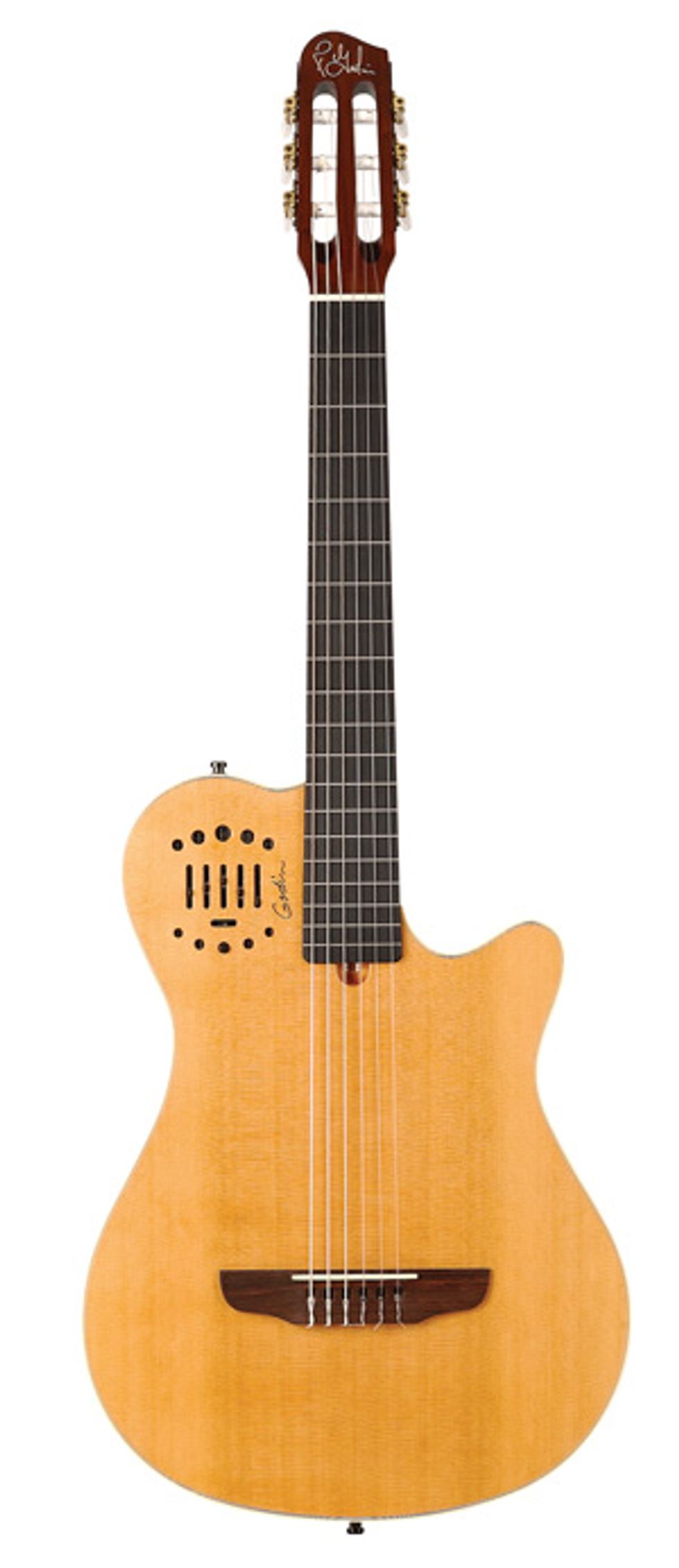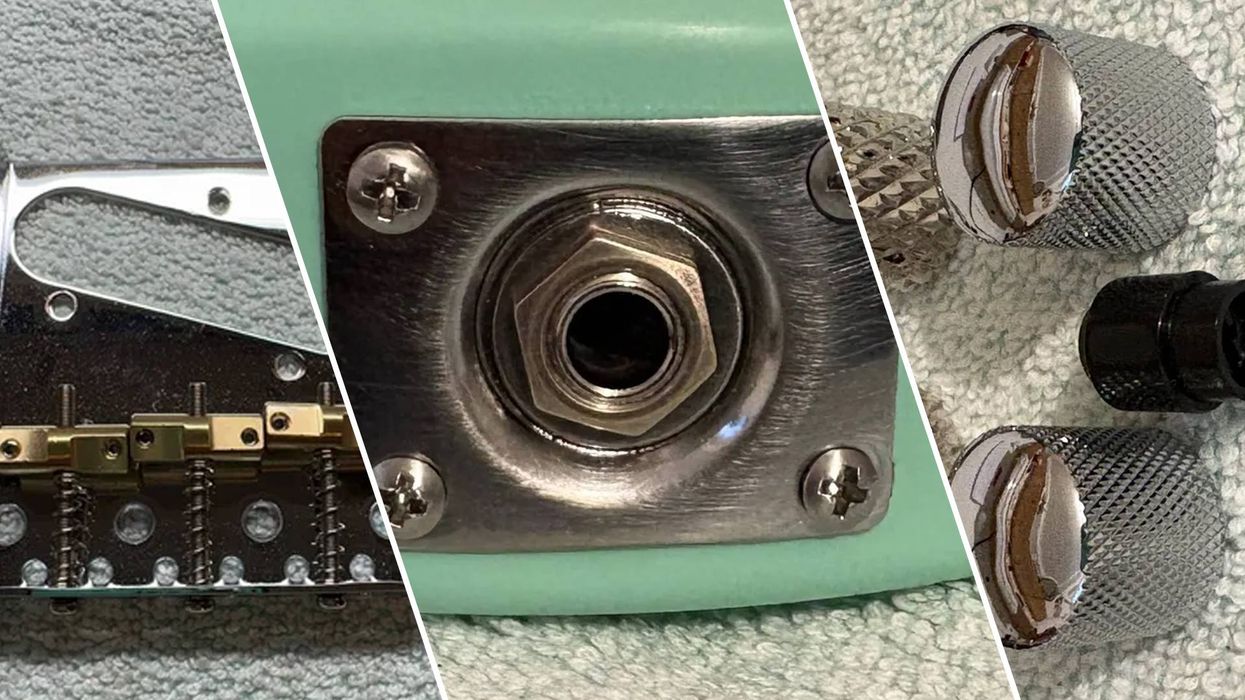 | |
| Download Example 1 Mic Imagining positions 1, 2, 3, 4. No FX | |
| Download Example 2 Slider set to Piezo for first 2 strums, Piezo/Mic Image (middle slider setting) for second 2 strums, slider set to Mic Image for last 2 strums. No FX | |
| Download Example 3 Duet: Rhythm: flat, mic image 1 panned slightly left. Lead: flat, mic image 1 blended with 30% peizo panned slightly right. Altiverb reverb and small string section in background. | |
| All clips were recorded with the Multiac into a Creation Audio Labs MW1 into Pro Tools | |
The Guitar
Sporting the classic Godin look, the Multiac is constructed of a chambered mahogany body with a solid cedar top and finished in a high-gloss sunburst tone. The neck is also mahogany and topped with an ebony fingerboard that measures 2" wide at the nut, much like a traditional classical guitar. Like a classical guitar, the fingerboard has no inlays whatsoever, but it does come with side dot markers on the 3rd, 5th, 7th and 12th frets for those of us who still need a little fingerboard roadmap. Following its Multiac siblings, all of the controls are placed in the same location as a Les Paul toggle switch, but that’s where the similarities end. Along with slider controls for Volume, Treble, Middle and Bass, are a new 4-way Mic-Imaging switch, Phase button and Blend slider.
The Mic-Imaging switch allows you to choose from four different modeled microphone styles: Danish Pro Audio Small Diaphragm Condenser Mic; Soundelux E47 Large Diaphragm Condenser; Schoeps CMC64G Small Diaphragm Condenser; and Schoeps CMC64G Small Diaphragm Condenser at a distance of 16". The other half of the Duet is the Fishman piezo bridge pickup, which shares itself along with the Mic Imaging on the blender slider, allowing continuous mixing of both the piezo and modeled microphone tones. The phase button lets you flip the sounds in or out of phase for massive tonal flexibility. The Multiac comes standard with a padded Godin gig bag with plenty of storage pockets for picks and supplies.
In Play
Before even plugging the in Multiac, I took it for a test drive to see how it fared purely as an acoustic instrument. While it didn’t have the same depth and dimension of a traditional nylon-string acoustic guitar, it still was surprisingly lively and immediate-sounding, with great articulation and clarity. The guitar weighed more than I expected, but considering it’s made of mahogany, it makes sense—and I suspect that the construction has a lot to do with its ability to reject feedback at high volumes. Since the fingerboard is wider than a steel-string guitar, it definitely takes a little getting used to. There is a greater space between the strings, but over time it became comfortable and second nature, and going back to a normal steel-string width actually felt a bit cramped. The neck is also slightly flatter, which helps accommodate the extra width of the fingerboard, and access to the top frets is aided in the comfortable neck pocket and lower cutaway. The guitar is superbly constructed, and there wasn’t a flaw to be found, save for the B-string tuner, which seemed a little loose and felt like it was slipping enough to take it out of tune. Over the course of time, I found that the strings were new and still stretching so tuning later became a non-issue, even though that particular tuner never felt quite as tight as the others.
Plugging the Multiac in directly to my Pro Tools rig via a Creation Audio Labs MW1 Studio Tool (an excellent device for DI and reamping), it was immediately clear that this guitar is ultra-versatile. Dialing up a great tone is as simple as plugging in. The controls offer huge flexibility when using just the Fishman piezo pickup and the accompanying Volume, Bass, Middle and Treble. Setting the Blend slider in the far right position engages only the piezo pickup, but as you slide to the left it begins blending in the Mic Imaging, with the piezo for ultimate tonal flexibility. To the far left, you will only hear the Mic Imaging—the four choices of mic models and distances I described earlier. Tonally, I found all of the four sounds to be very useful, depending on the style of music being played, but it was the use of the Blend control that really opened up the possibilities. For instance, I liked the piezo setting with a little bit of the mids cut while blending about 40 percent of the #2 Mic Image (based on the Soundeluxe E47 mic) for some of the solo acoustic playing on a recent Brazilian track I was working on. Noticing that it was a little too thick, I hit the Phase button to flip the phase relationship, and it thinned it out just enough to sit in the track without taking up unnecessary space. Remember, this is all being done as a direct sound using no FX or other EQ in Pro Tools. After spending a good deal of time playing it this way, I moved on to using it with the Jam 150.
Buy if...
you want an ultra flexible live and studio nylon string electro-acoustic guitar with no feedback.
Skip if...
you're an acoustic purist and want a traditional non-electric.
Rating...
Street $1349 - Godin Guitars - godinguitars.com |











![Rig Rundown: Russian Circles’ Mike Sullivan [2025]](https://www.premierguitar.com/media-library/youtube.jpg?id=62303631&width=1245&height=700&quality=70&coordinates=0%2C0%2C0%2C0)








